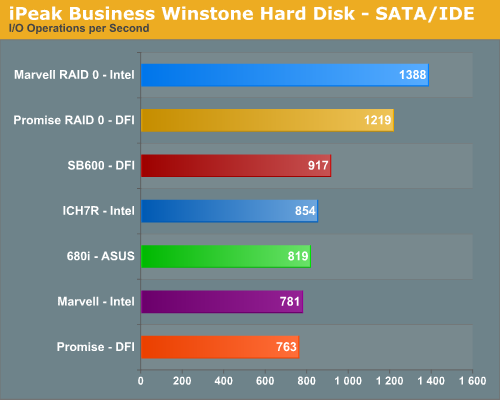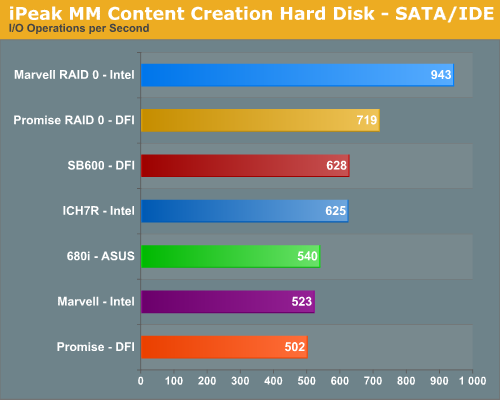DFI LANParty UT ICFX3200-T2R: ATI's, err, AMD's RD600 finally arrives
by Gary Key on December 16, 2006 7:00 PM EST- Posted in
- Motherboards
Disk Controller Performance
The AnandTech iPeak test is designed to measure "pure" hard disk controller performance, and in this case we keep the hard drive as consistent as possible while varying the hard drive controller. The idea is to measure the performance of each hard drive controller with the same hard drive.
We test with our raw files that are recorded I/O operations when running a real world benchmark - the entire Winstone 2004 suite. Intel's iPeak utility is used to play back the trace file of all I/O operations that took place during a single run of Business Winstone 2004 and MCC Winstone 2004. To try to isolate performance differences to the controllers that we are testing we are using the Western Digital 74GB Raptor with 16MB cache for both our standard disk controller and RAID performance tests for this article. The drive is formatted before each test run and a composite average of three tests on each controller interface is tabulated in order to ensure consistency in the benchmark.
iPeak gives a mean service time in milliseconds; in other words, the average time that each drive took to fulfill each I/O operation. In order to make the data more understandable, we report the scores as an average number of I/O operations per second so that higher scores translate into better performance. This number is meaningless as far as hard disk performance is concerned, as it is just the number of I/O operations completed in a second. However, the scores are useful for comparing "pure" performance of the storage controllers in this case.


The performance patterns hold steady across both Multimedia Content I/O and Business I/O with the SB600 outperforming the Intel ICH7R and NVIDIA 680i chipsets in our non-RAID tests. The Promise controller on the DFI board is the slowest of all solutions with the Marvell controller on the Intel 975X performing slightly better. In our initial RAID 0 tests with the Promise and Marvell controllers we see the Marvell controller once again finishing ahead of the Promise solution. This probably stems from the fact that we were limited to a 16KB Stripe size on the Promise controller while the Marvell was set at 128KB. Both auxiliary controllers have worked flawlessly to date once set up correctly.
Each controller ships with a web-based application used to set up the drives from Windows if that option is needed. However, DFI still has some BIOS tuning work to complete when utilizing the Promise controller. The manual says to use F4 to enter the controller setup but we had to use Ctrl-F which is the same setting utilized by the SB600 RAID setup. We had to choose which RAID setup to use as both were not available simultaneously, although we preferred the SB600 for daily use. Also, we noticed an issue in setting up either RAID solution on the DFI board with a USB keyboard and had to resort to a PS/2 connection. Finally, if we set the memory burst value to 8, then the board would lock if we had RAID enabled. DFI is working on a solution now, but at this point you need to work around the issues. We will provide full RAID results from the native controllers in our next article along with images of the Promise application.
Power Consumption

Our power consumption numbers are based on our test setup for this article and with power management turned off. This should come as no real surprise but the 680i is a power hog - or better yet it provides very good competition to the Intel Prescott for best utilization of a computer component as a space heater. The RD600 has slightly higher idle consumption numbers than the Intel 975X but consumes about 12% less power under load than the Intel board and 26% less than the ASUS 680i. Although the 680i consumes about 32% more power at idle than the RD600 or Intel 975X, the load numbers level off quickly when compared to the 975X. The results of the RD600 are very good and mimic the RD480 but are not as impressive as the RD580 from a chipset only level. Our system at stock voltages ran very cool but we did see power consumption increases almost equal the 975X when overclocking both platforms. We will present these numbers along with CrossFire results shortly.
The AnandTech iPeak test is designed to measure "pure" hard disk controller performance, and in this case we keep the hard drive as consistent as possible while varying the hard drive controller. The idea is to measure the performance of each hard drive controller with the same hard drive.
We test with our raw files that are recorded I/O operations when running a real world benchmark - the entire Winstone 2004 suite. Intel's iPeak utility is used to play back the trace file of all I/O operations that took place during a single run of Business Winstone 2004 and MCC Winstone 2004. To try to isolate performance differences to the controllers that we are testing we are using the Western Digital 74GB Raptor with 16MB cache for both our standard disk controller and RAID performance tests for this article. The drive is formatted before each test run and a composite average of three tests on each controller interface is tabulated in order to ensure consistency in the benchmark.
iPeak gives a mean service time in milliseconds; in other words, the average time that each drive took to fulfill each I/O operation. In order to make the data more understandable, we report the scores as an average number of I/O operations per second so that higher scores translate into better performance. This number is meaningless as far as hard disk performance is concerned, as it is just the number of I/O operations completed in a second. However, the scores are useful for comparing "pure" performance of the storage controllers in this case.


The performance patterns hold steady across both Multimedia Content I/O and Business I/O with the SB600 outperforming the Intel ICH7R and NVIDIA 680i chipsets in our non-RAID tests. The Promise controller on the DFI board is the slowest of all solutions with the Marvell controller on the Intel 975X performing slightly better. In our initial RAID 0 tests with the Promise and Marvell controllers we see the Marvell controller once again finishing ahead of the Promise solution. This probably stems from the fact that we were limited to a 16KB Stripe size on the Promise controller while the Marvell was set at 128KB. Both auxiliary controllers have worked flawlessly to date once set up correctly.
Each controller ships with a web-based application used to set up the drives from Windows if that option is needed. However, DFI still has some BIOS tuning work to complete when utilizing the Promise controller. The manual says to use F4 to enter the controller setup but we had to use Ctrl-F which is the same setting utilized by the SB600 RAID setup. We had to choose which RAID setup to use as both were not available simultaneously, although we preferred the SB600 for daily use. Also, we noticed an issue in setting up either RAID solution on the DFI board with a USB keyboard and had to resort to a PS/2 connection. Finally, if we set the memory burst value to 8, then the board would lock if we had RAID enabled. DFI is working on a solution now, but at this point you need to work around the issues. We will provide full RAID results from the native controllers in our next article along with images of the Promise application.
Power Consumption

Our power consumption numbers are based on our test setup for this article and with power management turned off. This should come as no real surprise but the 680i is a power hog - or better yet it provides very good competition to the Intel Prescott for best utilization of a computer component as a space heater. The RD600 has slightly higher idle consumption numbers than the Intel 975X but consumes about 12% less power under load than the Intel board and 26% less than the ASUS 680i. Although the 680i consumes about 32% more power at idle than the RD600 or Intel 975X, the load numbers level off quickly when compared to the 975X. The results of the RD600 are very good and mimic the RD480 but are not as impressive as the RD580 from a chipset only level. Our system at stock voltages ran very cool but we did see power consumption increases almost equal the 975X when overclocking both platforms. We will present these numbers along with CrossFire results shortly.










42 Comments
View All Comments
RichUK - Monday, December 18, 2006 - link
You seem to have missed the focus point of my initial comment. I didn’t insist DFI implement an active cooling solution, rather a more adequate solution.Atleast you somewhat agree with my original immediate argument:
I never wanted an active cooling solution, never. However, I had hoped DFI would implement a solution that would exceed the requirements for cooling this chipset. Hopefully this point will be moot when I receive my board, and when I receive my board I won’t have to do any sort of cooling modding.
yacoub - Saturday, December 16, 2006 - link
Actually most folks will be extremely pleased to see DFI finally move away from the godawful mobo chipset mini-fans. Those dinky fans are noisy and generally die very young . They cause more trouble than they're worth (hence why you see the vast majority of motherboards today have moved to passive cooling / heatpipe setups). Not only is a heatpipe setup quieter, it's also much lower maintenance.